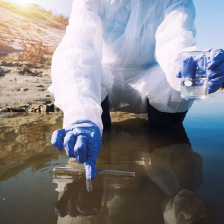European Drinking Water Directive
The Drinking Water Directive (EU) 2020/2184 of the European Parliament implements somatic coliphage testing in operational controls.
Drinking water directives are crucial to public health as they control water quality. This update incorporates suggestions from WHO, US-EPA, and the European Commission to enable coverage of many areas.
This chart summarizes the application of somatic coliphages according to the Drinking Water Directive (EU) 2020/2184 of the European Parliament. Check your country’s transposition.
What is the current definition of Drinking Water?
Drinking water shall be safe and clean at the point of compliance and free of microorganisms, parasites, or substances in an amount or concentration that may pose a risk to human health.
It shall meet the microbial requirements specified in Annex I and Annex II, among which Somatic Coliphages are incorporated as a new Operational Parameter.
Learn HOW to implement coliphage control in routine water testing at water supply points and in water supply areas.
The first thing to do is a Risk Assessment and Management
Be aware of this:
a) Risk assessment and management in the catchment areas will be the responsibility of the water administration.
b) Risk assessment and management in the supply areas in each of the infrastructures that compose it, from the intake to the service connection, will be the operator’s responsibility.


WHEN should risk assessment and risk management be done? Learn more about the deadlines for adapting PSAs according to the type of supply zone.
The water administration will carry out the risk assessment and management of the catchment areas
a) Risk assessment and risk management of the catchment areas of points of abstraction of water intended for human consumption shall be carried out for the first time by 12 July 2027 at the latest. That risk assessment and risk management shall be reviewed at regular intervals of not more than six years, taking into account the requirements laid down in Article 7 of Directive 2000/60/EC, and updated as necessary.
b) Risk assessment and risk management for the supply system shall be carried out for the first time by 12 January 2029 at the latest. Risk assessment and risk management shall be reviewed at regular intervals of not more than six years and updated as necessary.
c) The risk assessment of the home distribution system shall be conducted for the first time by January 12, 2029. This risk assessment shall be reviewed every six years and updated as necessary.
Learn more about the CONTROLS and surveillance you will need to implement for coliphage analysis.

Self-control: Carried out by the operator responsible for the supply area
Operational control: provide a rapid overview of operational performance and water quality issues to enable prompt implementation of corrective actions. These operational monitoring programs will be supply-specific, will take into account the results of hazard and dangerous event detection and risk assessment of the supply system, and will be aimed at confirming the effectiveness of all control measures with respect to abstraction, treatment, distribution and storage. Somatic coliphages shall be measured if the risk assessment indicates that it is appropriate to do so. If it is detected in untreated water at a concentration above 50 PFU/100 ml, it should be analyzed after the stages of the treatment cycle have been followed, in order to determine the degree of elimination achieved by the existing barriers and to assess whether the risk of pathogenic viruses surviving treatment is sufficiently controlled.
Find out the deadlines according to the transpositions of this regulation in your country
Read Francisco Lucena’s opinion – Bluephage co-founders, former Professor of Microbiology at the University of Barcelona, and former Director of the consolidated research group MARS – on the European Drinking Water Directive update.



